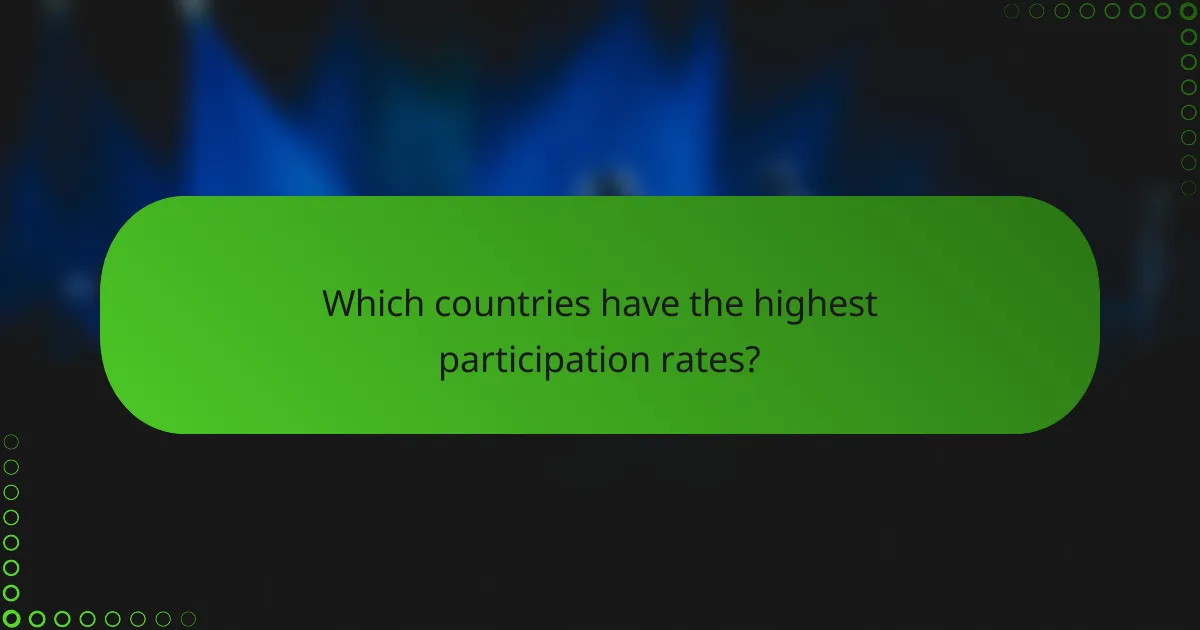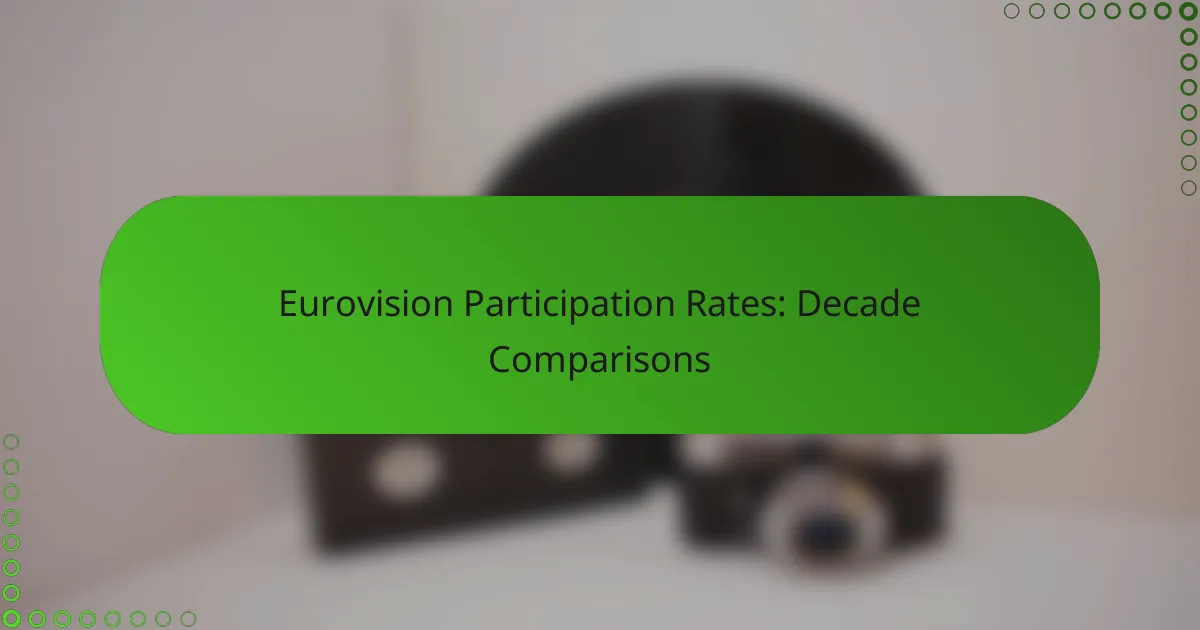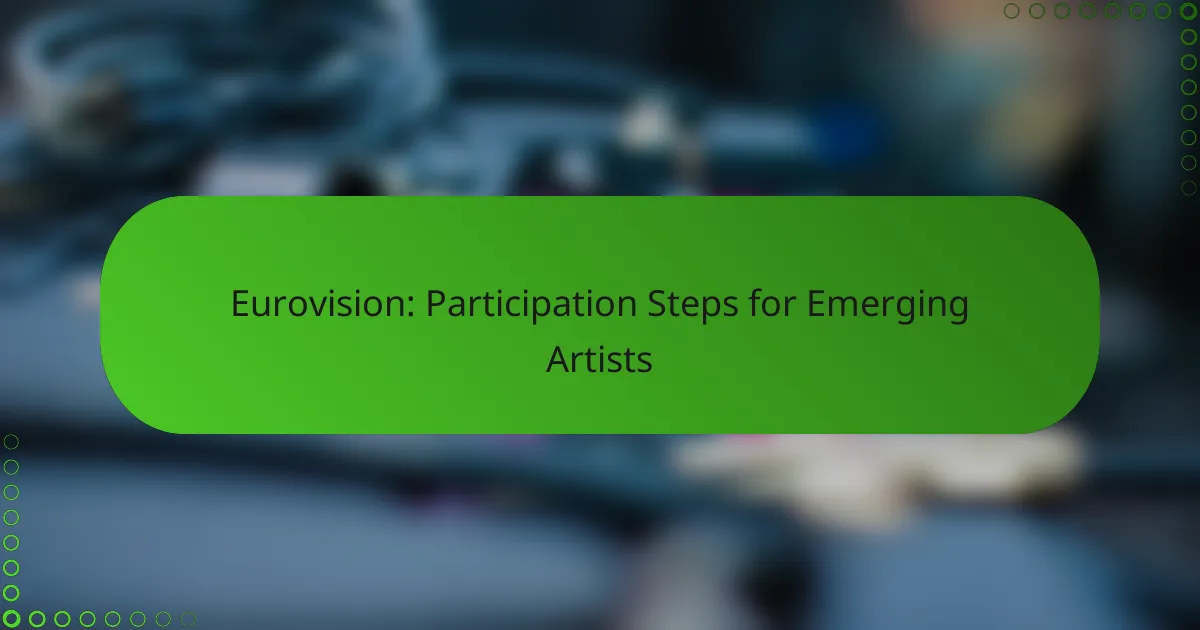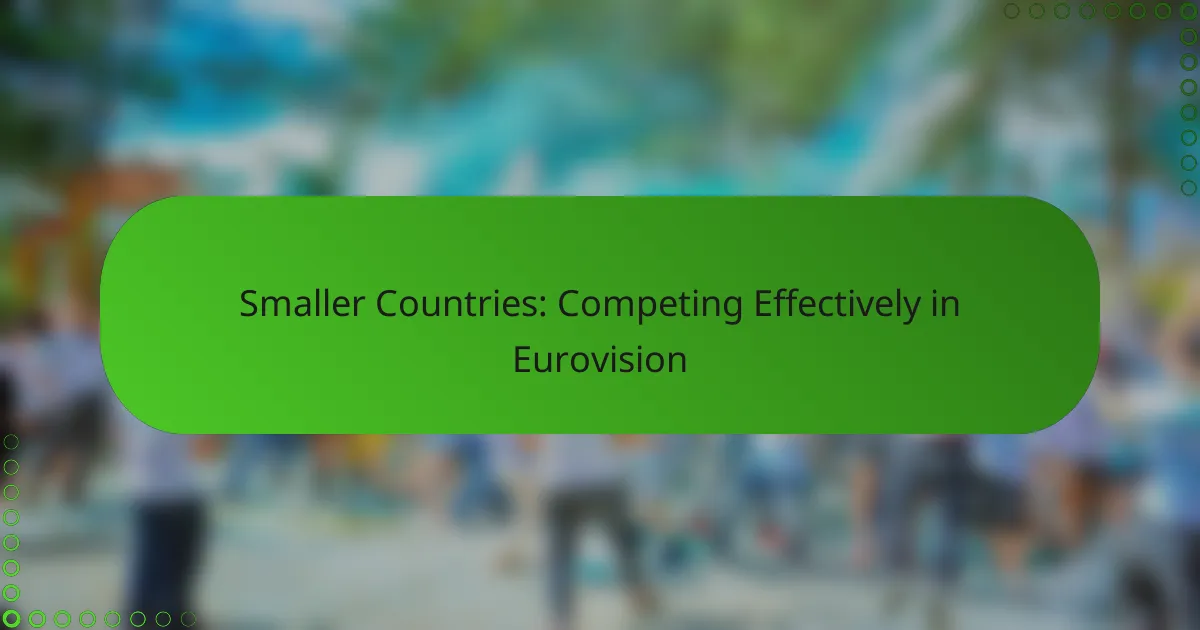Eurovision participation rates have experienced notable fluctuations over the decades, shaped by various political, cultural, and economic factors. From its modest beginnings with a limited number of countries, the contest has evolved to attract a diverse array of participants, reflecting broader changes in the global landscape. Understanding these trends provides insight into how the competition has adapted and grown in popularity over time.

What are the Eurovision participation rates by decade?
Eurovision participation rates have varied significantly across decades, reflecting changes in political, cultural, and social landscapes. Each decade has seen fluctuations in the number of participating countries, influenced by factors such as geopolitical events and the evolving nature of the competition.
Participation rates from the 1950s
The Eurovision Song Contest began in 1956 with only seven participating countries: Belgium, France, Germany, Italy, Luxembourg, Netherlands, and Switzerland. This initial event set the stage for future growth, as it was primarily a small-scale competition focused on promoting European unity through music.
During the 1950s, the participation rate remained low, with only the founding countries taking part. The format was simple, and the event was broadcasted in a limited number of countries, contributing to its modest reach.
Participation rates from the 1960s
The 1960s saw a gradual increase in participation, with the number of countries rising to around 12 by the end of the decade. New entrants included nations like Austria, Spain, and the United Kingdom, reflecting a growing interest in the contest.
This decade marked the introduction of more elaborate performances and a wider variety of musical styles, which helped to attract additional countries to the competition. The event began to gain popularity across Europe, leading to increased viewership.
Participation rates from the 1970s
By the 1970s, Eurovision participation rates had expanded significantly, with approximately 18 countries competing by the decade’s end. The contest became a platform for showcasing diverse musical talents and styles from across Europe.
This decade was notable for the introduction of voting systems that allowed for more audience engagement, further boosting interest and participation. Countries like Ireland and Sweden began to establish themselves as strong contenders in the competition.
Participation rates from the 1980s
The 1980s experienced a peak in participation, with around 20 to 22 countries entering each year. The contest became a cultural phenomenon, with nations like Norway and France joining the lineup, showcasing a rich variety of music.
During this time, the competition also began to embrace technological advancements, including improved broadcasting techniques, which helped to enhance the viewing experience and attract larger audiences.
Participation rates from the 1990s
This decade introduced a more competitive atmosphere, with countries investing more in their entries, leading to higher production values and diverse musical offerings. The introduction of semi-finals also changed the structure of the competition, allowing more countries to participate.
Participation rates from the 2000s
The early 2000s saw participation rates stabilize around 25 to 30 countries, with the introduction of new voting systems and the expansion of the contest’s format. Countries such as Bosnia and Herzegovina, and Serbia and Montenegro made their debut, further enriching the competition.
Increased globalization and the rise of the internet allowed fans from around the world to engage with the contest, leading to a surge in viewership and interest in participating countries.
Participation rates from the 2010s
The introduction of online voting and social media engagement transformed how audiences interacted with the contest, making it more accessible and inclusive. Countries like Australia were invited to participate, further expanding the contest’s global reach.
Participation rates from the 2020s

How have participation rates changed over the decades?
Participation rates in the Eurovision Song Contest have fluctuated significantly over the decades, reflecting changes in political, cultural, and economic landscapes. While the early years saw a limited number of countries, recent decades have witnessed a notable increase in participation, driven by the expansion of the contest’s appeal and the inclusion of more nations.
Trends in participation increase
In the last few decades, the Eurovision Song Contest has seen a marked increase in the number of participating countries. This growth can be attributed to the dissolution of political barriers and the rise of new nations eager to showcase their musical talent on an international stage. For instance, the 2000s introduced several Eastern European countries, contributing to a diverse range of performances.
Additionally, the contest’s format has evolved to attract a broader audience, with countries like Australia joining the competition in recent years. This trend indicates a growing global interest in the event, as nations recognize the potential for cultural exchange and tourism that participation can bring.
Trends in participation decrease
Conversely, some countries have opted out of the Eurovision Song Contest in recent years, leading to a slight decline in participation from specific regions. Factors such as financial constraints, dissatisfaction with contest outcomes, or political reasons have influenced these decisions. For example, countries like Turkey and Armenia have withdrawn, citing various grievances with the contest’s organization or political climate.
Moreover, economic challenges can deter nations from participating, especially if the costs of staging a competitive entry outweigh the perceived benefits. As a result, some countries may reassess their involvement, leading to fluctuations in overall participation rates.

What factors influence Eurovision participation rates?
Eurovision participation rates are influenced by a mix of political, cultural, and economic factors. Each of these elements can significantly affect a country’s decision to enter the competition, impacting both the number of participants and the diversity of entries.
Political factors affecting participation
Political relationships between countries can greatly influence Eurovision participation. Nations with strong diplomatic ties may be more inclined to participate, while those with strained relations might opt out. For instance, countries involved in ongoing conflicts may choose to withdraw to avoid negative publicity or backlash.
Additionally, national policies regarding cultural representation can play a role. Some governments may prioritize participation as a means of promoting national identity, while others may restrict it based on political agendas or public sentiment.
Cultural factors influencing entries
Cultural trends and societal values significantly shape the types of entries countries submit to Eurovision. Nations with a rich musical heritage often showcase traditional styles, while others may lean towards contemporary genres that resonate with younger audiences. This diversity can lead to varying participation rates based on cultural alignment with the contest’s themes.
Moreover, public interest and engagement with the competition can drive participation. Countries where Eurovision is a major cultural event tend to have higher entry rates, as citizens rally around their representatives and celebrate national pride.
Economic factors impacting countries
The economic situation of a country can directly affect its ability to participate in Eurovision. Nations facing financial difficulties may cut entertainment budgets, which can include funding for the contest. Conversely, countries with robust economies are more likely to invest in high-quality entries and promotional campaigns.
Furthermore, the costs associated with participation, such as staging performances and marketing, can deter some nations. Countries must weigh the potential benefits of exposure against the financial investment required to compete effectively.

Which countries have the highest participation rates?
The countries with the highest participation rates in Eurovision typically include those with a strong cultural connection to the competition and a history of consistent entries. Nations like Sweden, Norway, and the United Kingdom frequently dominate in terms of participation, reflecting their commitment to the event.
Top participating countries in Eurovision
Sweden leads the pack with a remarkable track record, having participated in nearly every contest since its inception. Norway and the United Kingdom also boast high participation rates, often sending entries that resonate with audiences across Europe.
Other notable participants include Germany and France, which have consistently entered the competition, showcasing a diverse range of musical styles. These countries not only participate regularly but also invest significantly in their entries, aiming for top placements.
Countries with consistent participation
Countries like Finland and Denmark have shown remarkable consistency in their Eurovision participation, often sending unique and innovative acts. This steady involvement helps maintain their visibility in the European music scene.
Additionally, nations such as the Netherlands and Italy have re-emerged in recent years, demonstrating a renewed commitment to the competition. Their consistent participation reflects a broader trend of countries valuing Eurovision as a platform for cultural expression and international exposure.

What are the implications of participation rates for future contests?
Participation rates in Eurovision contests significantly influence the competition’s dynamics, including diversity of entries and audience engagement. Higher participation can enhance the event’s appeal, while lower rates may limit representation and reduce viewer interest.
Impact on diversity of entries
Higher participation rates typically lead to a broader range of musical styles and cultural representations. This diversity enriches the contest, allowing audiences to experience a variety of performances that reflect different traditions and contemporary trends.
For example, when more countries participate, the competition showcases genres from pop to folk, which can attract a wider audience. Countries with unique musical heritages can introduce fresh sounds, making the event more vibrant and engaging.
Audience engagement and viewership
Participation rates directly affect audience engagement and viewership numbers. A higher number of countries competing often correlates with increased interest from fans, as viewers are more likely to tune in to see their country’s entry and support their favorites.
Countries that consistently perform well or have a strong fan base can drive up ratings, while those with lower participation may struggle to maintain viewer interest. Engaging content, such as behind-the-scenes footage and artist interviews, can further enhance viewer connection.
Long-term sustainability of the contest
Participation rates play a crucial role in the long-term sustainability of the Eurovision Song Contest. A consistent decline in participation could signal underlying issues, such as dissatisfaction with the contest format or political tensions among countries.
To ensure the contest remains relevant, organizers must address concerns raised by participating nations. This may involve revising voting systems, enhancing promotional efforts, or fostering a more inclusive environment to encourage broader participation.










